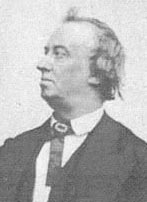David Rands has kindly shared with readers of the Victorian Web his site about the life and works of W. B. Rands, the prolific writer of children's literature and originator of The Boy's Own Paper. Readers may wish to consult this site for more information about this little-known figure who had an immense influence upon Victorian children. [GPL]

William Brighty Rands. 1877. [Click on image for larger picture]
Rands, William Brighty 1823-1882, "the laureate of the nursery," writing under the pseudonyms of Henry Holbeach and Matthew Browne, son of a small shopkeeper, was born in Keppel Street, Chelsea, on 24 Dec. 1823. He received a very limited education, and derived much of what he knew from a habit of reading at the second-hand bookstalls. He had a varied career, was for some years in a warehouse, then on the stage, and then a clerk in an attorney's office. Having taught himself stenography, he in May 1857 entered the employment of Messrs. Gurney & Co., and was soon appointed a reporter in the committee-rooms of the House of Commons. Here he proved very efficient, and after attending, during a session of the house, a committee on the merits of the Armstrong and Whitworth ordnance, he received a vote of thanks from the committee. Ill-health occasioned his resignation in August 1875.
When parliament was not sitting he spent his time in literary work by special arrangement with his employers, and wrote much in verse and prose. At an early period he became a member of the staff of the Illustrated Times, and from 13 Oct. 1855 to 24 June 1871 furnished the greater part of a weekly article on men and manners, entitled "The Literary Lounger". In the meantime he commenced writing for Cassell's Boy's Paper, St. Paul's Magazine, Good Words, Good Words for the Young, and The Peep Show. To The Argosy (vols. iii. and iv.), in 1867, he contributed, under the name of Henry Holbeach, a tale entitled "Shoemakers' Village." For the Contemporary Review he wrote very many articles under the pseudonyms of Henry Holbeach and Matthew Browne; the earliest, called "Moral Criteria and Moral Codes," appeared in December 1869 (pp. 584-600). To the Saturday Journal, published by Alexander Strahan between April 1874 and April 1875, he furnished twelve four-leaf Monthly Supplements of Notes, Literary, Social, and Scientific; and to Tait's Edinburgh Magazine a number of articles entitled "Reading Raids." He was a reviewer in the Pall Mall Gazette in its early years, and in his later days wrote many articles in the Spectator. In 1878 he aided in founding the Citizen newspaper in the city of London.
He died at Luton Villa, Ondine Road, East Dulwich, Surrey, on 23 April 1882, and was buried in Forest Hill cemetery, leaving four (sic) children. Rands was in many ways an eccentric character. His domestic life was somewhat irregular; but he was for some time a regular preacher in a chapel at Brixton, and composed hymns of great force and originality. One, commencing "One Lord there is all lords above," which appeared originally in his Lilliput Lectures (1872), has been included in Horder's Congregational Hymns (1884), and in the Congregational Church Hymnal (1887) (Julian, Hymnology, 1892, p. 951; [on the Congregationists]). As a poet he showed a keen love of nature and a sense of the music of words. His first book, brought out in 1857, and one of the few to which his name is attached, was called Chain of Lilies and other Poems. In after years he regarded it as crude and unsatisfactory. It is as a writer of verse for children that his position was most secure. Mr. James Payn called him, in Chambers's Journal, the laureate of the nursery, and had he done no more than write the lyric Beautiful World, in his Lilliput Lectures (1871), he would have claimed remembrance. His fairy tales, of which he published one every Christmas for many years, combined much delicate fancy with well-contrived allegory; the chief of them were reprinted in Lilliput Legends. His elaborate book on Chaucer's England, 1869 (2 vols.), under the pseudonym of "Matthew Browne," is an admirable piece of work.
Related Materials
Sources
Daily News, 26 April 1882, p. 2.
Pictorial World, 17 June 1882, pp. 371-2 (with portrait).
Contemporary Review, November 1869, pp. 398-412.
Miles's Poets of the Century, 1893, v. 115-130
Information from W. H. Gurney Salter, esq., Paul W. Rands, esq., and Alexander Strahan, esq.
�
Last modified 23 October 2005